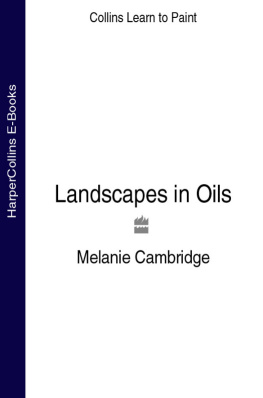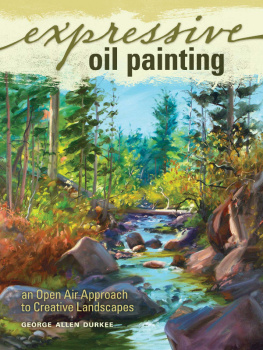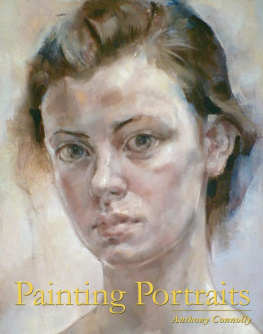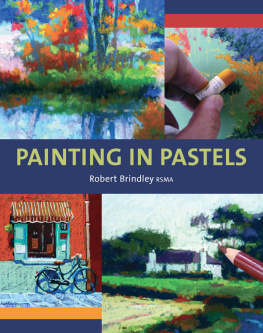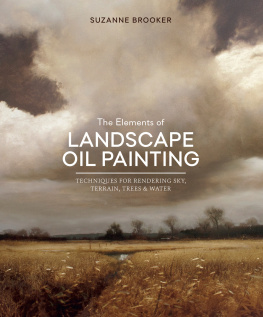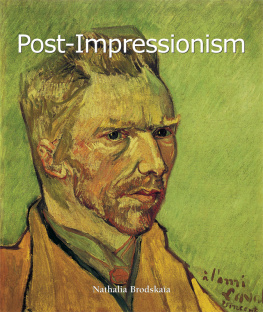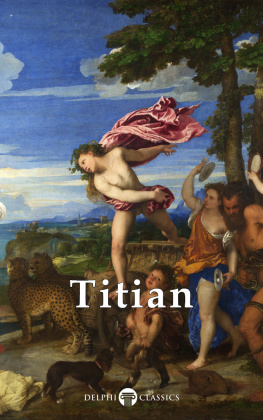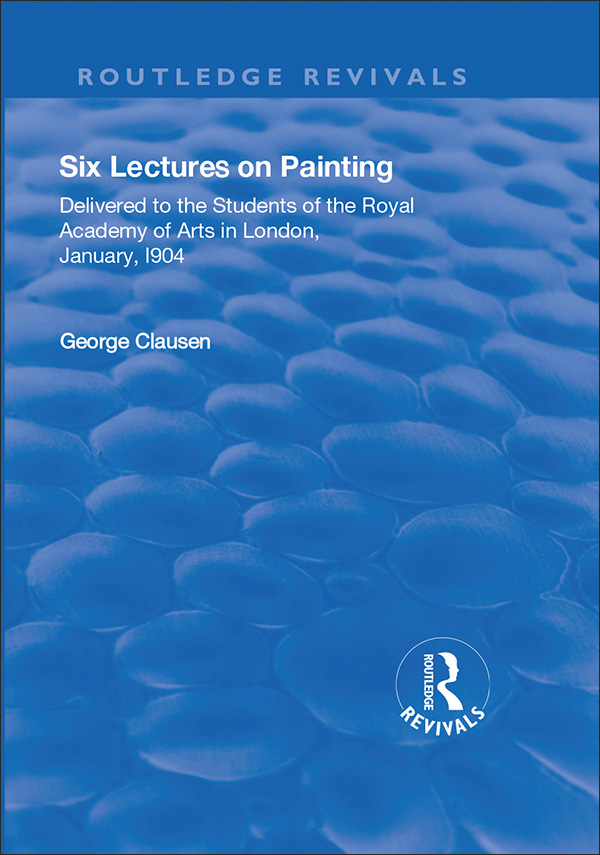Contents
Routledge Revivals
PAINTING
SIX LECTURES
ON
PAINTING
DELIVERED TO THE STUDENTS
OF THE ROYAL ACADEMY OF ARTS
IN LONDON, JANUARY, 1904
BY
GEORGE CLAUSEN, A.R.A., R.W.S.
PROFESSOR OF PAINTING
IN THE ROYAL ACADEMY.

First published 1904 in by Elliot Stock
This edition first published in 2018 by Routledge
2 Park Square, Milton Park, Abingdon, Oxon, OX14 4RN
and by Routledge
711 Third Avenue, New York, NY 10017
Routledge is an imprint of the Taylor & Francis Group, an informa business
1904 Taylor & Francis
All rights reserved. No part of this book may be reprinted or reproduced or utilised in any form or by any electronic, mechanical, or other means, now known or hereafter invented, including photocopying and recording, or in any information storage or retrieval system, without permission in writing from the publishers.
Publishers Note
The publisher has gone to great lengths to ensure the quality of this reprint but points out that some imperfections in the original copies may be apparent.
Disclaimer
The publisher has made every effort to trace copyright holders and welcomes correspondence from those they have been unable to contact.
A Library of Congress record exists under ISBN: 37015670
ISBN 13: 978-1-138-55052-0 (hbk)
ISBN 13: 978-1-315-12332-5 (ebk)
CONTENTS

THE VIRGIN OF THE ROCKS
Leonardo da Vinci, National Gallery]
SIX LECTURES
ON
PAINTING
DELIVERED TO THE STUDENTS OF THE ROYAL ACADEMY OF ARTS IN LONDON, JANUARY, I904
BY
GEORGE CLAUSEN, A.R.A., R.W.S.
PROFESSOR OF PAINTING IN THE ROYAL ACADEMY.

NOTE
THESE Lectures are not printed exactly as they were delivered; in preparing them for publication, some slight alterations in their form have been made.
G. C.
List of Illustrations
I
INTRODUCTORYSOME EARLY PAINTERS
SO much has been achieved in painting, so much is to be learnt, that no artist, occupied as he must be with his own work, can have the necessary detachment of mind and the leisure to review impartially, and with proper appreciation, the history and practice of painting to the present day. The field is too wide. At most, he can give such rough conclusions as his own work, and the study of others work, has led him to form.
In the time of Sir Joshua Reynolds and for long after, hardly a painter earlier than Raphael was considered seriously ; but now, and speaking roughly, since the days of the Pre-Raphaelite movement, which did so much for our art, we have learnt to know and to appreciate the great work of the earlier painters.
I think we may consider that extraordinary genius, William Blake, who was once a student of these schools, to be the real forerunner of the Pre-Raphaelite movement. Writing in 1809, he draws attention to the clearness and beauty of the early Italian pictures, praising their precision and hardness, which he contrasts with the art of Rubens, Titian, and Rembrandt, whom he calls smudgers, blunderers, and daubers.
At about the same time, too, as the Pre-Raphaelite movement came the invention of photography, which has, I think, exercised a disturbing influence on our art ; and a little later the art of the Japanese became known among us. So many theories are in the air to-day, so many courses are open to us, that it is more than ever difficult for the student to find his way ; and though, knowing my own shortcomings, I feel strongly my inadequacy, I will do my best to give you such help as, were I a student in your place, I should wish to receive.
I imagine the intention of the Royal Academy in establishing this Chair was to supplement the teaching of the schoolsthe life class, which is a training of the hand and eye, the tools of the artist, so to speakwith some direction of the mind also, so that the student should be not only equipped with sound technical skill, but be put on the track of some direction, or at least given indications, which would help him to decide how he should apply his skill when he goes out into the world. For the artists education does not finish in the life class ; it begins there.
In the old days, when there was the constant relation of pupil to master, theory and practice went hand in hand. The training was thorough, the best obtainable, but limited. An artist knew at most what a few others were doing round about him, and was, as a rule, content to develop himself on the lines of the traditions and with the instruction he had received. And so arose the schools of one place and another.
But to-day we are at once worse off and better. We have lost all traditionalmost the tradition of fine workmanship. With the exception of the Pre-Raphaelite painters, no moderns have attained the wonderful, almost miraculous, perfection and delicacy of execution which we find in the best old paintingsnot achieved once or twice only, but steadily and consistently for a long period. But we are better off in that we have before us, brought into the open light of discussion and criticism, the whole practice of painting, for our admiration and guidanceand confusion ; for our wider knowledge has brought uncertainty, and every man is a law unto himself. We are also under the disadvantageif it is a disadvantageof there being practically no direct commands for pictures, such as the Church or the great patron furnished in former days, which allowed the artist full liberty of expression under the restraint of a given idea.
We have long been without this ; in fact, the varied developments of painting in the last century are owing to the freedom which artists enjoy, or I might say to the necessity which every artist feels himself under, to express his own feeling ; and this accounts for the somewhat chaotic and confused impression which our big exhibitions produce, as a whole, in spite of so much excellent work.
Portraiture, which is vigorous and flourishing, and wall decoration, in which, thanks to the initiative of the late Lord Leighton, some essays are being made, are the only branches of our art that rest on the simple basis of direct demands. It is to be hoped that those who have the power will do all that is possible in the direction of encouraging fine decorative painting ; for the conditions of decorative work are such as necessarily to develop the best faculties of the artist and the finest qualities of painting.
But I dont want to paint my picture too black, or to imply that our painting is in decadence, for I think it is advancing ; and although we live in times when everything is in the melting-pot, including the Fine Arts, we know that the instinct for beauty, and for its expression in the Fine Arts, is as natural and as necessary to our being as any other of our instincts, and that the cry of decadence is as old as the world itself. There is a comforting little story told by Lanzi in his book on Italian painting, of Orcagna the Florentine artist, who was living somewhere about 1320, at the very beginning of Florentine art. He gives it on the authority of a contemporary writer, Sacchetti, that one day Orcagna proposed as a question, Who was the greatest master, setting Giotto out of the question ? Some answered Cimabue, some Stephano, some Bernardo, and some Buffalmacco. Taddeo Gaddi, who was in the company, said : Truly these were very able painters, but the art is decaying every day. And I think that Michelangelo said that in his time the arts were not much considered. So we may conclude that the relation of the artist to the world in general was always much the same as it is now. As in other departments of human activity, painters have done well or ill, as it has been given them to do ; succeeding generations of artists have cherished their memories, or have forgotten them, according to the estimation in which they held their work.




